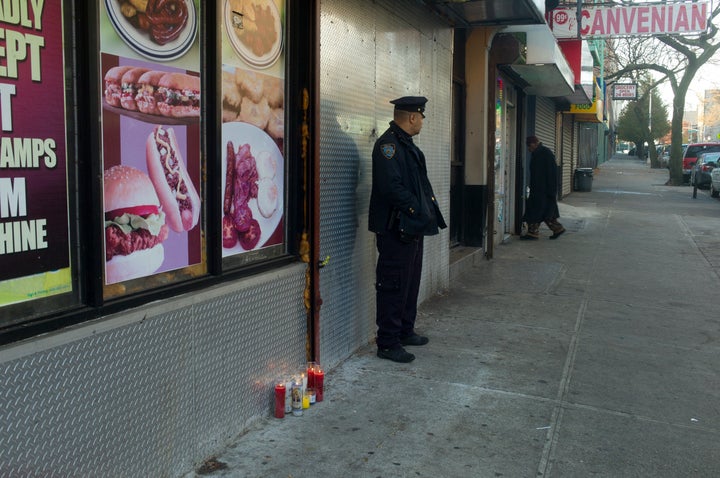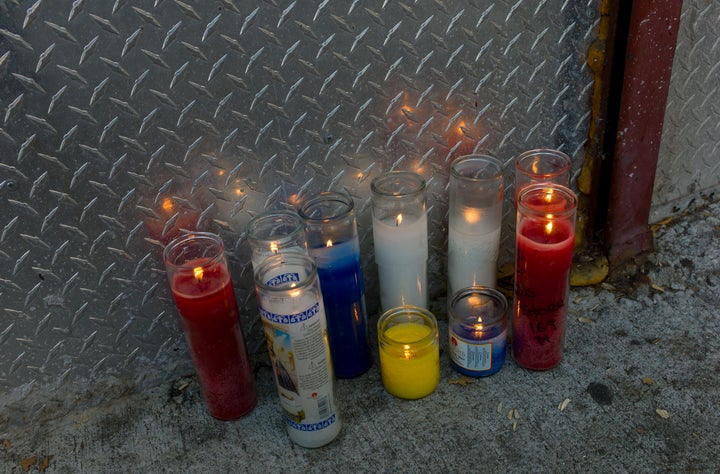
UPDATE: Feb. 9 ― The New York City Police Department plans to send 75 new investigators to the Bronx, the department said Wednesday. The announcement comes five weeks after The New York Times published a data analysis showing that precinct detectives in the Bronx, on average, carry more than twice the case load on violent felonies than their counterparts in Manhattan and Staten Island.
Read The Huffington Post’s interview with the authors of this service journalism, which could help save lives, below.
Previously:
Al Baker and Benjamin Mueller of The New York Times spent a year writing about every single murder in the 40th Precinct of the Bronx. While the murder rate has dropped to all-time lows in many other parts of New York City, this precinct, a mostly black and Hispanic community, has seen persistent violent crime.
Usually these types of stories are fodder for tabloids ― Man Fatally Shot, Brother Injured ― with scant information about the victim, beyond their gender and circumstance of death.
But at the beginning of 2016, The New York Times decided to go deeper than the basics, to tell the story of each victim’s life ― and death. Baker and Mueller, along with other reporters, immersed themselves in the community, spending time with the deeply traumatized families and the severely under-resourced police department.
The Huffington Post talked to Mueller and Baker about what it was like to report these stories. This conversation has been edited for clarity and length.
What was the seed of the story? Did you pitch it or did an editor?
Al Baker: It was a group decision. There was a desire to tell the story of crime in New York in a more meaningful way than in an annual end-of-year recap.
Benjamin Mueller: It’s always been a struggle to write meaningful crime stories. For a daily story, it’s hard to get depth on who the victim was. We rely on coded cues from the police, a signal to the reporter that there was some sort of criminal activity. These stories mean nothing to the reader and you end up writing 350 words on a person who got killed, but it tells nothing about the victim, who they were and why they were killed.
AB: For this series we had a goal: We wanted to figure out why the murder happened and what the police were doing about it.
So many murders get skipped by the press. It’s a big city. For this series we decided not to skip any. We wanted to treat each story as a big long tale, like we would for a story about a cop killing. We decided to treat them all as big stories worth our attention.
How did you begin?
BM: We had to figure out where to write about first. We worked up files on precincts where crime is still high. We came up with two precincts in the Bronx and Brooklyn. We also researched what the neighborhoods were like, the demographics, the type of public housing.
AB: We needed something manageable. We knew we had a 12-month period and we knew how deeply we wanted to report each story, the murderer and the murdered. We didn’t want to get caught in the same trap of giving each story short shrift. We needed to find a place where crime was persistent, but also a place we could manage journalistically.
What tipped it over to the Bronx?
BM: We waited for the first homicide of the year. It was in the Bronx. A woman had been killed in the hallway outside of her apartment. We started trying to get to know her and her family. We had a lot of trouble learning about the man who killed her. He had had mental health difficulties for a while.
We tried to put the murder into context, the challenge of predicting when mental illness might become violent. The challenge of living in public housing. A lot of people are fearful. They triple-lock their doors. The don’t talk to reporters, the police or their neighbors. We tried to understand the government institutions who helped the victim or the mentally ill.
AB: Ben went back up there a week later and found they still hadn’t cleaned up the blood. The victim’s friends and family were on their hands and knees cleaning it up with cleaning supplies, scrubbing blood off the floor. It was such a haunting reminder of how quickly people are forgotten by the city. These horrific tragedies are unseen. Imagine someone in that much anguish has to go through that and no one witnesses it. It’s hard to imagine that happening in many places in the world, really.
“People are used to reporters showing up for a day and then disappearing. Being there for the third or fourth day didn’t by default make them open up, but it did get them to be more trusting.”
- Benjamin Mueller, The New York Times
How did you build trust with the victims?
AB: It’s time. That’s what journalism needs.
BM: People are used to reporters showing up for a day and then disappearing. Being there for the third or fourth day didn’t by default make them open up, but it did get them to be more trusting.
I hung out for hours and hours in the lobby where one victim’s friends were building a memorial, picking up new things about him, who his friends were. Beyond time, it is also the accumulation of information, learning something from court documents or public records. And then we’d bring back that information to the victim’s family and friends and they see you’re not coming to them blank. You are coming to them with information.
AB: Information builds. You become such an authority in some ways, they become invested in wanting to inform you even more. Now they know why it’s important for them to speak, to put into context the past, to try and shed light on what their loved one endured.
Ben, you tell people, “We are here and we need you to help us understand what went wrong,” and we would just keep coming back. We had the luxury of being able to say, “Just think about it, we’ll be back.” And by the time we came back, we had read the court file or talked to the cops, and sometimes we had information they didn’t even know. Then they were invested in explaining and we were invested in getting it accurate and getting at the nuance.
We had time to gather more information, and we had the trust of our editor. He had confidence in our ability to tell the story, and we had his backing and his support of us in these pursuits.
BM: We understood why they didn’t want to talk to us. We knew we were showing up at the most horrific time possible in their lives.

What was it like getting the police’s point of view of the story?
AB: I spent a lot of time with them. It’s the same principle. They’re people like everyone else. And just as it was important to spend time with the relatives of the dead, it was just as important to spend time with the people who were charged with trying to make sense of it from a societal point of view, the crime of it.
BM: I think you put it well. It’s a kind of police work that doesn’t get a lot of attention. The detectives are spending every waking minute to give justice to these families. We rarely tell the story of that aspect of what they do. They’re telling the victim’s family what next steps there are. They’re helping them make sense of what happened. The police spend more time than anyone else in the city trying to understand what happened to the victim. Their work deserved to be told.
Go Behind The Scenes With Other Reporters:
- How Do You Write About A Man Who Doesn’t Know Who He Is?
- A White Nationalist Changes His Mind
- The PTA Mom And The Power Couple From Hell
- A Fashion Photographer Takes A Stand At Standing Rock
- Behind The True Crime Podcast Everyone Should Be Listening To Right Now
- How ‘Doonesbury’ Creator Saw Donald Trump’s Candidacy Coming A Mile Away
- This Is What It’s Like To Go Back to Rikers
- You’ve Never Seen These Black History Photos Before
- A Glimpse Into The Syrian Refugee Crisis Through Virtual Reality
Every week, HuffPost Must Reads features a behind-the-scenes look at how long-form journalism is made. We go under the hood. Why did the writer take that unexpected angle? How hard was it to get that source on the record? We’re here to tell that story. Sign up here.
